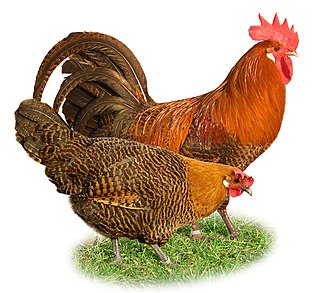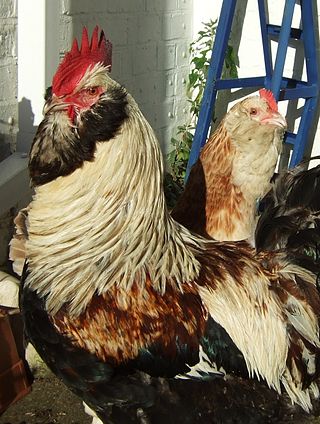
The Leghorn, Italian: Livorno or Livornese, is a breed of chicken originating in Tuscany, in central Italy. Birds were first exported to North America in 1828 from the Tuscan port city of Livorno, on the western coast of Italy. They were initially called "Italians", but by 1865 the breed was known as "Leghorn", the traditional anglicisation of "Livorno". The breed was introduced to Britain from the United States in 1870. White Leghorns are commonly used as layer chickens in many countries of the world. Other Leghorn varieties are less common.

The Braekel or Brakel is a traditional Belgian breed of chicken. It is thought to have originated in the area of Brakel, in the Flemish province of East Flanders, for which it is named. There is a bantam version of the Braekel. The Campine of the United Kingdom derives from it.

The Brahma is an American breed of chicken. It was bred in the United States from birds imported from the Chinese port of Shanghai, and was the principal American meat breed from the 1850s until about 1930.

The Ancona is a breed of chicken which originated in the Marches, region of Italy, but which was bred to its present type mainly in the United Kingdom in the nineteenth century. It is named after the city of Ancona, capital of the Marche. It is popular in Britain and the United States, but uncommon in Italy; an initiative to re-establish it in its native area and preserve its biodiversity was launched in 2000. There are also Ancona bantams.

The Faverolles is a French breed of chicken. The breed was developed in the 1860s in north-central France, in the vicinity of the villages of Houdan and Faverolles. The breed was given the name of the latter village and the singular is thus also Faverolles, not Faverolle. The final "s" is silent in French.

The Barbu d'Anvers, Dutch: Antwerpse baardkriel, is a breed of bantam chicken from Belgium. It is a true bantam, and has no full-sized counterpart; males weigh about 700 grams and hens about 600 g. The Barbu d'Anvers is one of the oldest bantam breeds, and is thought to have originated in the province of Antwerp in northern Flanders. It is the only Belgian bantam breed not threatened with extinction. In the United States it may be called the Antwerp Belgian or Belgian Bearded d'Anvers.

The Scots Grey is a dual-purpose breed of domestic chicken originating in Scotland, where it has been bred for more than two hundred years. It was formerly known as the Scotch Grey and until about 1930 was popular in Scotland. It is on the "Native Poultry Breeds at Risk" list of the Rare Breeds Survival Trust.
The Bianca di Saluzzo is a traditional breed of chicken originating in the Piedmont region of north-western Italy. It takes its name either from the town of Saluzzo, in the province of Cuneo, or from the former Marquisate of Saluzzo, which approximately coincides with its area of distribution. It may also be called the Bianca di Cavour, after the nearby town of Cavour, in the province of Turin.

The Bionda Piemontese is a traditional Italian dual-purpose breed of chicken. It originates in the Piedmont region of north-western Italy, from which it takes its name. It may also be called the Bionda di Cuneo, after the comune of Cuneo or the surrounding province; Bionda di Villanova, after the comune of Villanova d'Asti in the province of Asti; Rossa delle Crivelle, after a village near Buttigliera d'Asti; or Nostralina.
The Ermellinata di Rovigo is a modern Italian breed of dual-purpose chicken. It originates in the city of Rovigo in the Veneto region of north-eastern Italy, from which it takes its name. It was created between 1959 and 1965, principally from Sussex and Rhode Island Red parentage.

The Robusta Lionata is a modern Italian breed of dual-purpose chicken originating in the city of Rovigo in the Veneto region of north-eastern Italy. It was created between 1959 and 1965, by cross-breeding Buff Orpingtons with the commercial strain known in Italy as "White America".
The Robusta Maculata is a modern Italian dual-purpose breed of chicken. It originates in the city of Rovigo in the Veneto region of north-eastern Italy, where it was created between 1959 and 1965 by cross-breeding Buff Orpingtons with the commercial strain known in Italy as "White America".
The Romagnola is a traditional Italian breed of dual-purpose chicken from the Emilia-Romagna region. It was formerly widespread in central Italy, but in the late twentieth century came close to extinction. In early 2012 the population was recovering and the breed was awaiting official recognition by the Federazione Italiana Associazioni Avicole, the federation of Italian poultry associations.
The Pépoi or Pepoi is a rustic Italian breed of small dual-purpose chicken from north-eastern Italy, particularly the Veneto and Friuli-Venezia Giulia regions. It is not officially recognised as a breed in Italy, but is being considered for recognition.
The Mericanel della Brianza is a breed of small chicken or bantam from Lombardy, in northern Italy. It takes its name from the Brianza, an area to the north-east of Milan, and from mericanell, a Lombard diminutive of merican "American". In early 2012 it was the only officially recognised Italian bantam breed.

The Padovana or Padovana dal gran ciuffo is an ancient Italian breed of small crested and bearded chicken. It originates in, and is named for, the city and surrounding province of Padua, in the Veneto region of north-eastern Italy. Despite continuing discussion surrounding its true origins, it is recognised in Italy as an indigenous Italian breed.

The Polverara, also known as Schiatta (Italian) or S'ciata (Venetian), is an ancient breed of crested chicken from the area of Polverara in the province of Padua, in the Veneto region of north-eastern Italy.

The Valdarno is an Italian breed of black dual-purpose chicken. It originates in, and is named for, the lower part of the Valdarno, the valley of the Arno river, in Tuscany in central Italy. It became virtually extinct in the twentieth century, but the population is recovering. It is a quite different breed from the Valdarnese, which originates in the upper Valdarno, and is white.

The Valdarnese, also referred to as Valdarnese Bianca, Valdarno Bianca or Pollo del Valdarno, is a breed of large white chicken from the upper Valdarno, the valley of the Arno river, in Tuscany, central Italy. It became virtually extinct in the 20th century, but the population is recovering. It is a different breed from the Valdarno chicken, which originates in the lower part of the Valdarno, and is black.

The Siciliana is an ancient Italian breed of chicken from the Mediterranean island of Sicily. It is notable for its unusual double or rose comb, for the early age at which birds reach maturity, and for the unusual shape of the eggs. The Sicilian Buttercup, bred in Australia, Great Britain and the North America, derives from it, but its long separation from the original stock has led to marked differences between the two.














